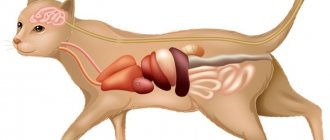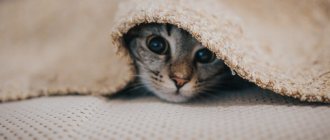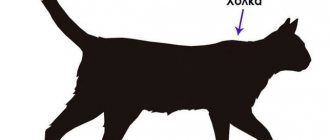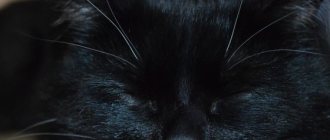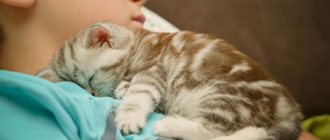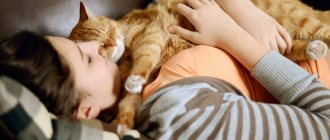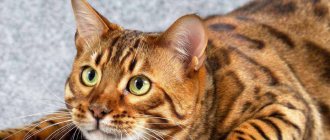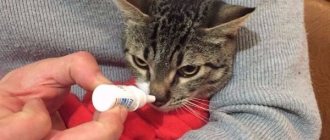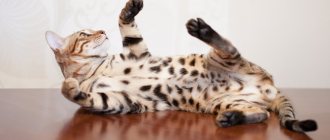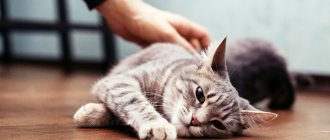How can you find out the gender of a kitten?
There are several ways to determine the sex of a kitten. Not one of them is considered 100% accurate - it’s much more reliable to carefully examine the animal’s genitals. However, if you are unable to conduct an inspection, pay attention to other external signs. So, a cat and a cat are distinguished:
- By color. It is believed that you can distinguish a cat from a cat by looking at the color of the animal's fur. For example, the tricolor pattern is most often found in females. While male kittens most often have red fur. Tortoiseshell coat coloring is a more striking indicator, since it can only be found in cats.
- On the face. In small newborn kittens, the shape of the muzzle is the same in both boys and girls. However, with age, it can also determine the gender of the kitten. For example, cats have a small and slightly elongated muzzle, while cats have a large and round muzzle.
Anatomy of a cat
Additional reproductive disorders in male cats may include:
- cryptorchidism
- Inflammation of the testicles
- Inability to retract the penis (paraphimosis)
- Persistent erection (phimosis)
If you notice anything abnormal about your cat's testicles or penis, we recommend consulting with your veterinarian as soon as possible. For more information, read My cat has swollen testicles: causes and treatment..
When is the best time to determine the gender of a kitten?
Many owners of furry cats are interested in when is the best time to find out the gender of the kitten. Based on the recommendations of veterinarians, the most noticeable signs of differences in the sexes of fluffy animals appear at the age of 2 months. Then, even without any experience, you can easily distinguish a boy from a girl through a simple examination.
Of course, this can be done a little earlier, but then there is a risk of receiving unreliable information. Surely, you have heard more than once how a kitten, once named Vasily, over time (due to incorrect gender determination) turns into Vasilisa and gives birth to kittens.
At the same time, experts recommend not touching, lifting or turning over small kittens under 3-4 weeks of age. Let the animal get used to the world around it so that the examination does not become a stressful situation for it.
How to conduct an inspection - what is possible and what is not?
The best way to distinguish the sex of a kitten is to conduct a thorough examination of the fluffy one. How to do everything right and avoid mistakes? During the inspection you must:
- hold and turn the kitten as carefully and carefully as possible;
- place the kitten exclusively on its stomach, and not on its spine;
- do not conduct examinations on cats that are too young (up to 3 weeks);
- monitor the reaction of the kittens’ mother; if she is not delighted with this idea, it is better not to touch the babies;
- avoid a lot of unnecessary movements.
During inspection, under no circumstances should you:
- lift the kitten by the tail;
- inaccurately and abruptly turn the animal over;
- tear the kitten away from feeding for examination;
- holding small fluffies (3-4 weeks old) in your hands for too long - this can affect the animal’s thermoregulation;
- apply strong pressure to the kitten's stomach or genitals.
It is also important to prepare the correct location for the inspection and all the necessary items. To do this you will need:
- a clean, soft, warm towel on which you will place the kitten;
- additional light source (if necessary).
Hello student
Foreskin
The foreskin, or prepuce, praeputium, of a male dog is adjacent to the ventral abdominal wall and directed towards the navel. The end of the foreskin, covering the narrow prenucial opening, ostium praeputiale, is free along the entire circumference. This makes it easier to retract the foreskin when inserting the penis. The preputial sac is covered with a mucous inner layer. In the area of the bottom, fundus praeputii, this inner leaf turns into a hollow leaf. The transition site is at the top of the bulb of the head. The internal and penile layers, lamina interna praeputii and lamina penis praeputii contain a large number of lymph nodes; purulent inflammation often occurs. The system of thin vessels of the mucous membrane and arteriovenous anastomoses are described by Ninomiya Nakamura (1981 a, b).
Veins run parallel to arteries and bear the same names; dorsal vein of the penis, V. dorsalis penis, vein of the bulb of the penis, v. bulbi penis, deep vein of the nenis, v. profunda penis. All of them, connecting in the vein of the penis, flow into the internal pudendal vein, v. Pudenda interna. At the same time, the outflow of blood from the glans penis occurs through the external pudendal vein, v. Pudenda externa. All veins have reliable valves. In addition, during the erection process, the outflow of blood is blocked due to squeezing of blood vessels and due to contraction of the muscles of the penis. For a more detailed description of the mechanism of erection, see Christensen (1954)
Rice. 15. Pars libera penis and foreskin, transverse section (according to Schummer, 1987)
a os penis; b urethra in sulcus urethralis, surrounded by the corpus spongiosum of the penis; with pars longa glandis, cavernous tissue; d lamina penis praeputii; e lamina interna praeputii
Cranial preputial muscle, m. praeputialis cranialis, a loop covers the preputial foramen. During an erection, the outflow of blood from the penis into the external pudendal vein is blocked by it. Caudal preputial muscle, m. praeputialis caudalis, is not always present.
The penis, the penile part of the urethra and the foreskin of a cat
The penis of a cat is relatively short and, unlike males of other domestic animals, is directed caudally. Since the designation of the parts of the penis is determined by the principles of comparative anatomy, it therefore turns out that the dorsum of the penis, dorsum penis, is located ventro-cranially, and the penile part of the urethra is adjacent to the body of the penis from the dorso-caudal side. The structure of the cat's penis is described by Jackson (1902), Wagner (1909) and Redlich (1963), its corpora cavernosa - by Koniget al. (1979)
The cavernous body of the penis, corpus cavemosum penis, has the shape of a harpoon tip. Its legs, crura penis, are attached to the ischial arch. They are approximately 7 mm long and meet each other at an obtuse angle. The length of the trunk, truncus penis, is approximately 12 mm. It gradually narrows and passes into the bone of the penis, os penis. At the wide base of the bone of the penis there is a semblance of a urethral groove; the length of the bone of the penis is 3.5 -5.5 mm. In kittens, the bone of the penis begins to form after 3 months of life.
The tunica albuginea, tunica albuginea, of the corpora cavernosa of the penis consists of two layers; the outer layer of longitudinally oriented fibers is absent on the legs and in the urethral groove. On the back of the trunk, the apical ligament of the penis, ligamentum apicale penis, is formed from bundles of longitudinal fibers, which is attached to the bone of the penis and during erection passively directs the head of the penis cranially (Redlich, 1963).
Rice. 16. Diagram with the nomenclature of the cat’s penis
Left: parts of the corpus cavernosum of the penis, right: parts of the spongy bodies of the urethra and glans penis, middle: parts of the penis as a whole.
Rice. 17. The principle of the structure of the tunica albuginea of the cavernous body of the cat’s penis (according to Redlich, 1963) a ligamentum apicalc penis; b outer wall layer, c inner wall layer; d transverse and horizontal trabeculae; e trabeculae of the septum
Trabeculae extend inward from the tunica albuginea, trabeculae corporum cavemosorum, which in the form of transverse bridges are located in the cavity of the caverns or participate in the formation of the septum, which in the cat is not continuous; The trabeculae of the septum are round in cross section. Between the connective tissue-muscular trabeculae there are caverns, cavernae corporum cavernosorum, surrounded by elastic fibers. Large caverns are oriented along the longitudinal axis and communicate with the caverns of the opposite side. Small cavities completely fill the legs and peripheral areas of the trunk, especially its distal half. In the distal part of the cavernous bodies of the penis, the main structural element, as Jackson (1902) established, is adipose tissue, so that a kind of “articular part” is formed here (Redlich, 1963), with the help of which the penis bends cranially during erection.
The spongy body of the penis, corpus spongiosum penis, is covered with a thinner tunica albuginea. The paired thickened bulbs of the penis, bulbi penis, closely reach the bulbourethral gland. The spongy part emerging from the pelvic part of the urethra passes under the bulbs and further through the spongy body of the penis. Thus, the spongy layer communicates with the spongy body of the urethra. It covers the urethra up to the head of the penis, becoming increasingly thinner towards the head.
Rice. 18. Pars libera penis of a cat, dorsal view (after Schummer, 1987)
a glans penis; b lamina penis praeputii; with fundus praeputii; d lamina interna praeputii, here covers the extended body of the penis 1 trenulum praeputii
Rice. 19. Schematic representation of the normal (A) and erect (B) position of the cat’s penis, view from the lateral side (according to experimental studies by Redlich, 1963) a crus penis; b truncus penis; with os penis
1 so-called articular part in the corpus cavernosum penis: 2 ligamentum apicale penis; 3 m. retractor penis
The spongy body of the glans penis, corpus spongiosum glandis, consists of two or three layers of coarse cavernous tissue, forming a cap, which at the apex is pierced by the external opening of the urethra. In the internal space of the cap there is the final part of the spongy body of the penis, as well as the bone of the penis. Under the bone of the penis, that is, from the back, the cap is split. In general, the corpus spongiosum forms the urethral and lateral surfaces of the glans penis.
The foreskin covering the head bears approximately 120 keratinized denticles arranged in rows. Wagner (1909) reports specific terminal nerve bodies at the base of the denticles. On the non-erect penis, the tips of the denticles are adjacent to the head; during erection, they rise as a result of the enlargement of the head. After castration, their involution occurs. The erection process was experimentally studied by Redlich (1963). In this case, the shaft lengthens by 1 1/2 times, the diameter of the penis increases by 2 times. The direction of the axis passively changes as the apical ligament of the penis pulls the glans cranially and the body of the penis bends at the so-called articular part.
A cat's thickened foreskin is located under the scrotum. The prenucial foramen is directed caudally. The short inner leaf at the bottom of the prepuce passes into the genital leaf, equipped with denticles. When the penis extends, the inner leaf covers the body of the penis.
The blood vessels of the cat's copulatory organ belong to the system of the internal pudendal artery, which, after the vessels branch off from it to the urethra and bulbourethral gland, continues as the artery of the penis and is divided into three branches, similar to the circulatory system of the male penis. The smallest branch is the dorsal penile artery, a. dorsalis penis, in a cat it does not participate in the blood supply to the penis, but stretches to the foreskin. Artery of the penile bulb, a. bulbi penis, goes into the bulb, supplies it and the corpus spongiosum of the penis with blood, then reaches to the head and also vascularizes the corpus spongiosum of the glans. Deep artery of the penis, a. profunda penis, is responsible for the blood supply to the corpus cavernosum (for more details, see Konig et al., 1979). Dorsal vein of the penis, v. dorsalis penis, drains blood not only from the foreskin, but also from the corpus spongiosum of the glans and the distal part of the corpus spongiosum of the penis. Otherwise, the veins run the same way as the arteries of the same name.
Rice. 20. Lymph nodes and lymphatic vessels of the urinary and genital tract of a male dog in situ (but Baum, 1918)
1 lymphonodi iliaei mediales; 2, 2′ lymphonodi lumbales aortici; 3 lymphonodi sacrales; 4 lymphonodi scrotales; 5, 6 lymphatic vessels of the inner layer of the penis; 7 lymphonodi scrotales, vasa efferentia; 8 lymphatic vessels of the kidney capsule, going, like the lymphatic vessels of the testis, to the lymphonodi lumbales aortici a os ilii (sawed off); b ventral abdominal wall; from the bottom of the pelvis; d lumbar muscles; e aorta, f v. cava caudalis; g a. iliaca externa sinistra; h a. iliaca interna dextra; i vesica urinaria; k prostate; l urethra; m ligamentum vesicae laterale; n ureter; o m. coccygeus (cut off); p slice m. adductor; q m. bulbospongiosus; r m. ischiocavernosus; s penis; v praeputium; v' skin of the scrotum; w testis; x epididymis; in funiculus spermaticub, y' ductus deferens; z ren sinister
Ischio-cavernous muscle, m. ischiocavernosus, bulbospongiosus muscle, m. bulbospongiosus, and the muscle that retracts the penis, m. retractor penis, in principle, pass and act in the same way as in a male dog. No special studies have been carried out on the muscles of the cat’s copulatory organ.
Features of innervation and lymphatic drainage in the genital organs of dogs and cats: the dorsal nerve of the penis, the dorsalis penis, extending from the pudendal nerve, contains sensitive fibers of the penis, including the head and foreskin, as well as vegetative fibers of the blood vessels involved in erection. The regional lymph nodes for the testes and testicular appendages are the aortic lumbar lymph nodes, for the pelvic part of the urethra and accessory sex glands - the medial iliac and sacral lymph nodes, for the penis, foreskin and scrotum - the scrotal lymph nodes.
How to tell a boy's kitten from a girl's
Even if the animal’s genitals have not yet formed, there are several ways to determine the sex of a cat. Today I will tell you about the most popular and effective ones. Using these methods, you can 100% distinguish a girl from a boy kitten.
To begin the examination, you should carefully pick up the kitten and place it on a previously prepared towel. Raise its tail a little, watching the animal’s reaction. If the baby is scared, it is better to postpone the procedure.
The main differences between boys and girls appear from a very early age:
- The distance between the genitals and the anus in cats is much smaller than in small cats. This is one of the easiest ways to determine the gender of a kitten by eye.
- The shape of the genitals in kittens of different sexes is also different. Lift the kitten's tail and look - if you see a colon, then this is a small cat. If you see the Latin letter “i” upside down, you are holding a girl kitten in your hands.
- Palpation of the animal’s genitals can be done from the age of 3-4 weeks. Find the desired spot and gently move it with two closed fingers. Boy cats develop testicles from birth. So in this case you will feel small formations.
Why does my cat take out his penis??
If you notice that your cat's penis is protruding outside the foreskin, this could be a sign of a urinary problem. Urinary infections These are common in male cats. In general, you may also notice that your cat licks the area, showing signs of discomfort when urinating, and the penis may turn purple...
If you notice these symptoms of a penile infection in your cat, we recommend contacting your veterinarian immediately, especially if your cat is not urinating at all. Cat urine infection can affect the kidneys and lead to kidney failure if not treated early, which can be fatal...
Feline urinary tract infections (UTIs) may require prescription medications. This infection can also be caused by stress, in which case it contributes to further enrichment of the environment.
For more information, read Why is my cat pushing and licking his dick?
Video: how to determine the sex of newborn kittens
In order to better understand how to determine the gender of a newborn kitten or an older cat, we recommend that you watch a useful video. It discusses in detail all the main aspects of the differences between male and female kittens, and also provides important recommendations for examining the animal.
As you can see, determining the sex of a newborn kitten is quite difficult. Some people even seek the help of a veterinarian for this. However, using all the recommendations described above, you will quickly be able to figure out whether the kitten in front of you is a boy or a girl. It is not even necessary to wait a couple of months before the first important signs appear. The main thing is to approach this issue carefully and do everything as carefully as possible.
Were you able to find out the gender of your kitten? Share in the comments which of the methods listed above you used for this.
If you consider yourself a “dog person”, it is strictly forbidden to read further, but cat lovers, on the contrary, absolutely need to read the Factrum as carefully as possible - “cat people” will find a lot of interesting things in it!
Cats are much more careful in lapping than dogs.
Instead of simply scooping up water with its tongue, as a dog does, a cat, when lapping up milk or other liquid, touches the surface with the rough tip of its tongue and draws it into the mouth along with the resulting column of liquid, while closing its jaws to prevent the moisture from spilling out. back.
A cat can lap at a rate of four times per second, receiving about 0.1 ml of liquid each time - so it can drink about 5 tablespoons (24 ml) per minute.
A little about cat sex
Cats, like males of many other animals, have small spines on their penises. Scientists still cannot say unambiguously what function these outgrowths, about 1 mm long, perform, but most agree that the spines do not allow the penis to slip out of the female’s vagina during ejaculation and, in addition, serve as an additional source of sexual stimulation for both the cat and for the cat.
Male hormones are responsible for the formation of spines, so if a cat is sterilized at an early age, the amount of hormones will greatly decrease and the spines will either not grow at all, or their number will not be very large.
Digestive system
The cat's digestive system consists of:
- esophagus;
- stomach;
- small intestine;
- duodenum;
- jejunum;
- liver;
- large intestine.
The esophagus has a hose-like shape of a relatively small size, and connects the animal’s mouth and its stomach. The esophagus originates from the inner base of the mouth, extends through the neck and chest, passes close to the heart, extends through the muscles of the diaphragm, and connects to the stomach.
https://www.youtube.com/watch?v=ytcreators
The cat's stomach is single-chambered, and is distinguished by the location of the mucous membrane on its inner walls. The cat's stomach is adapted to accommodate a large amount of food, but it is almost never completely filled, since cats are not prone to gluttony (the vast majority).
Also, the inner surface of the stomach is dotted with folds, which have an additional mechanical effect on the process of breaking down food. Food processed by gastric juice enters the duodenum through the pyloric sphincter. Most often, eaten food remains in the stomach for about 12 hours.
The small intestine is a tubular organ that connects the stomach and large intestine. Often the length of a cat's small intestine is about 1.5-2 meters, and includes the duodenum, jejunum, and ileum.
The duodenum is small in size and serves to mix food with liver and pancreatic enzymes, which is extremely important for digestion.
The jejunum is the longest part of the small intestine, and its internal walls are dotted with thin hairs, which, when in contact with food that comes into contact with them, penetrate into it and suck out all the useful substances. It is here that the final extraction of all useful substances from food occurs, after which it enters the ileum, and then the large intestine, where it turns into feces.
The large intestine in cats works like in all mammals: it serves to temporarily store feces, as well as remove it from the anus. Also here, the walls of the large intestine absorb moisture from the feces stored in it, in order, if necessary, to maintain the necessary water balance in the body.
The liver is the largest gland in the cat's body, and breaks down nutrients obtained from the stomach and intestines into elements necessary for the body. It is important to note that in order to fully produce the required complex of amino acids, the cat must receive 90% protein in its diet, otherwise the animal will die, because the liver will not be able to provide the body with the necessary substances from plant foods.
READ Compatibility of angelfish with other fish in the aquarium General diagram of the structure of the internal organs of cats
Modern cats are often obese
In recent years, the problem of excess weight increasingly concerns not only people, but also their furry pets. According to research from the Association for Pet Obesity Prevention, about 54% of dogs and cats are overweight to some degree. This means that there are approximately 324 million “fat cats” among domestic cats around the world.
Most often, problems with excess weight in domestic cats begin due to a lack of physical activity and loving owners who, indulging their pets, give them too much food. A typical adult cat needs between 180 and 220 calories per day, and the average cup of cat food, for example, contains almost 400 calories.
Endocrine system
The endocrine system is primarily responsible for hormones and their production in the corresponding organs. Thus, the cat’s brain produces antidiuretic hormone, oxytocin, corticotropic hormone, adrenocorticotropic hormone, cortisol and growth hormone.
The adrenal glands produce a lot of other hormones, the main purpose of which is to regulate metabolism, and are also responsible for behavioral characteristics. The adrenal glands also produce cortisol, a small portion of testosterone, as well as epinephrine and norepinephrine.
There are a number of other glands of external and internal secretion, the principle of operation of which is common to all mammals.
...but cats are still intelligent in their own way
Let dogs interact much more actively with people; don’t assume that cats can only eat, sleep and force you to regularly change the cat litter. Domestic cats, like their relatives living in the wild, have all the necessary skills to, for example, outsmart prey or deceive an enemy.
In 2010, Wildlife Conservation Society staff managed to film the hunt of the long-tailed margay cat, which lives in the Amazon forests. Wanting to get one of the small tamarin monkeys for dinner, the cat quite accurately imitated the cries of these animals, and when some of the tamarins got closer, she set up an ambush. Only the warning cry of the leader saved one of the monkeys from reprisal, but it can be assumed that in the end the patient margay finally achieved her goal, or went off to look for other, less capricious prey.
Nervous system
The nervous system of cats is divided into central and peripheral. Each of these systems in a cat performs functions that are standard for most mammals.
The central nervous system consists of the brain, brain stem and the so-called spinal cord. The central nervous system is the most important in the body of any living creature, and simple and complex reactions, as well as some reflexes, depend on it. In addition, the central nervous system interacts with the peripheral and autonomic ones, ensuring their functioning and control.
The peripheral nervous system is responsible for the cat's conscious motor abilities. So, thanks to this system, a cat can move its paws, extend its claws, run, and generally lead the lifestyle that it leads. Also, the peripheral nervous system transmits pain impulses to the central nervous system from any part of the body where peripheral nerve endings are present.
Cats live for 10 minutes
Cats are able to remember any obstacle in their environment for only about 10 minutes - this conclusion was made by experts based on the results of a study conducted in 2007.
During the experiment, scientists created artificial barriers that furry subjects had to overcome. It turned out that if you stop a cat after it has stepped over an obstacle with its front paws and do not allow it to continue on its way for 10 minutes, the animal forgets that it is necessary to step over the barrier with its hind paws too, although if you stop it for a short time, the barrier will be “taken” practically straightaway.
The visual memory of cats is much shorter than the muscular memory - if you distract the pet from an obstacle before it begins to overcome it, the cat forgets about the unsolved problem.
Predisposing factors
Let's consider the main causes of the disease, which are most often encountered in veterinary practice:
- Physical trauma . When cats fight, anything can happen. It happens that it comes down to a severed scrotum. Any damage to the mucous membranes in such delicate places is a wide and welcoming gate for infection, an open “invitation” to pathogenic and conditionally pathogenic microflora.
- bathe from time to time , remember that chlorinated water is not the best bath liquid. Chlorine is a strong irritant, its action may well lead to the development of inflammation of the foreskin.
- Infectious organisms (yeast, pathogenic fungi, bacteria or viruses).
- Very often (in almost all cases) phimosis . This term refers to a pathology in which the foreskin “protrudes” and does not cover the head of the penis. Since cats don’t wear panties, it turns out to be open to “all winds” and other negative environmental factors.
- wash them almost The pathology may be confused in this situation with dermatitis of unknown etiology (NSD). By the way, don’t wash your pet every day. The skin of animals is very sensitive to detergents, and such “care” will not lead to anything good.
Cats control you
This fact will be confirmed by all cat owners without exception - pets do not just meow and purr, but in this way try to establish communication with the owner. In the process of evolution and living side by side with people, these cunning creatures have developed a cry of a special timbre, which a person perceives as unbearably shrill and disgusting. Of course, cats most often use this method of training people when they want to get something edible and, as a rule, achieve the desired result.
Musculoskeletal system
The location of a cat's organs in the musculoskeletal system is throughout the body. The movement apparatus consists of bones, muscles, ligaments and cartilage that form the skeleton.
The axial skeleton includes:
- scull;
- spine;
- thoracic region
The skeleton of a cat consists of 230 bones.
The dexterity and mobility of cats is ensured by the special structure of the skeleton.
Cat parasites can turn you neurotic and kill you
Cats are capable of not only controlling people, but also infecting them with parasites that directly affect the human personality. Microorganisms of the species Toxoplasma gondii are transmitted to cats from rats and mice, which, under the influence of this parasite, behave very recklessly and themselves look for places where they can encounter cats. If a furry pet manages to eat an infected mouse, the microbes will most likely appear in its owner, which is fraught with the development of toxoplasmosis , a disease that can noticeably change a person’s behavior.
A study conducted in 2006 found that after infection with Toxoplasma gondii, people's anxiety levels increase, their reactions slow down, neurotic traits appear, and for a person with a weak immune system, toxoplasmosis can even become fatal.
Sense organs
The sense organs are represented by a group of important components, which include: vision, smell, taste, hearing. The correct functioning of this system ensures the health of the cat, as well as survival in different conditions.
Visual
Cat eyes are the largest of all pets. Developed vision allows the animal to see not only small details and prey, but also navigate in the dark. The cornea protrudes forward, so the viewing angle is 250°.
Interesting! Experts have found that cats are able to distinguish up to 6 colors.
Auditory
Cats' hearing allows them to detect sound with a frequency of up to 65 kHz. The ear canal consists of 3 parts:
- Outer ear. This part is located on the pet’s head. With its help, sounds are captured and collected, and then transmitted to the eardrum.
- The middle ear transmits the signal from the membrane to the inner ear.
- The inner ear converts sound vibrations into nerve impulses.
Taste buds
Felines are able to distinguish almost all tastes, except sweet. Special papillae located on the tongue help recognize food. Each papilla contains about 30,000 taste buds.
Smell and touch
The sense of touch is accomplished through the whiskers. They are located in front of the pet's face. Animals are able to perceive 2 times more odors than humans. The main organ of smell is the nose. However, there is an additional organ on the upper palate - Jacobson's organ.
Interesting! A cat's nose has a unique imprint comparable to a human finger.
Nowadays there is a “cat population explosion”
Of all the consequences of rising average annual temperatures for cat lovers, the most joyful thing will be the fact that the increase in the duration of warm periods automatically extends the breeding season of cats, which means that more kittens will be born over time. Unfortunately, many of them are at risk of becoming strays, since there has not been a sharp increase in the number of people wanting to get a cat.
Back in 2007, experts noted an increase in the birth rate in cats, which is due to the fact that winters are becoming shorter and shorter, and this trend continues to this day. If you already have a cat and you can’t afford to get a couple more, but the thought that the adorable fluffy little ones will have to be drowned or taken to a cat shelter is unbearable for you, all that remains is to sterilize the animal and the problem with cat overpopulation, at least, for you personally, will be decided.
Circulatory system
The circulatory system in cats works the same way as in other mammals: the heart pushes blood through arteries that have elastic walls and rhythmically carry out contraction and relaxation movements. It is thanks to such movements that arteries located close to the skin can be felt, and this is called the pulse. The cat's pulse is easiest to detect on the inside of the thigh, and in a healthy animal it should range between 100-150 beats per minute.
The cat's brain absorbs 15-20% of the blood, the muscular system absorbs up to 40% of the total blood, and about 25-30% of the blood goes to the internal organs. During physical activity, muscles can absorb up to 90% of the blood, which is why cats get tired so quickly, but can focus maximum strength for a short period of time.
The animal's heart is a hollow organ located in the chest, just behind the breastbone. An important nuance is the fact that the weight of a cat’s heart depends on their weight, and does not have clearly established standards. Most often, the heart of an animal weighs 0.6% of the total body weight. The cat's heart consists of 2 ventricles and 2 atria.
The cat has a double circulation. The main blood circulation is provided by capillaries and arteries connected to the heart, which connect to all internal organs. The second circle of blood circulation is provided by veins, which pump blood into the right ventricle of the heart, straight through the lungs and their arteries.
Cat blood has high clotting rates compared to humans, and it cannot be replaced with the blood of other animals, as this can lead to the death of the cat. The bulk of the blood is yellow plasma, 30-45% are red blood cells, and the rest is allocated to white blood cells and platelets. Cat blood has 3 groups: A, B, AB. Cat blood type AB is extremely rare, which should be taken into account by owners of such animals.
Cat genitals
• The scrotum is a cavity of the sac-like protrusion of the abdominal wall, which ensures the maintenance of the temperature necessary for the maturation of sperm (several tenths of a degree lower than in the abdominal cavity). In cats, the muscles of the scrotum can pull it towards the groin if it is too cold outside. The scrotum is located between the penis and the anus.
• The spermatic cord is a fold of the peritoneum that contains blood vessels, nerves leading to the testis, as well as lymphatic vessels and the vas deferens emerging from it.
• The testes are paired, egg-shaped organs located in the scrotum. The diameter of each testis in cats is 1-1.5 cm. In the tubules of the testes, sperm are produced by a special epithelium.
• The epididymis is a narrow, repeatedly coiled duct adjacent to the testis. Sperm from the testicular canals enter the epididymis, where they acquire the ability to “swim” and fertilize.
• The vas deferens (vas deferens) is a duct that connects the duct of the epididymis to the urethra.
• The urethra is a tube of mucous and muscular membranes that ends in an opening on the head of the penis through which sperm is expelled.
• The prostate gland is an exocrine gland located at the junction of the urethra and the vas deferens. Through the ducts of the prostate gland, its secretion enters the urethra, which activates the activity of sperm.
• Bulbourethral glands are paired exocrine glands that secrete a secretion - pre-ejaculate, which lubricates and cleans the urethra for better passage of sperm. They are located at the base of the penis and open into ducts into the urethra.
• The penis is the external genital organ designed to introduce sperm into the cat's genitals. The penis of an uncastrated cat is covered with skin and short hair, as well as short keratinized spines (there are from 100 to 200 of them). The length of the cat's penis is 1 cm, the width is 0.5 cm at the base.
• Prepuce – the foreskin, a fold of skin that covers the head of the penis when at rest.
Anatomy of the structure of the feline genital organs in a cat
The reproductive system of a pet includes:
- external genitalia;
- uterus;
- ovaries;
- mammary glands (some consider them to be part of the pet’s reproductive system).
Urine is removed from the pet’s body thanks to the female’s external organs and vagina.
They are released at the moment of mating with the male, and conception occurs in the oviducts. In the uterus, the fetus continues to grow and develop.
Due to the physiological structure of the cat's body, the cervix is in a closed state - this protects the pet from foreign infections. The cervix opens only when the female goes into heat. During mating, sperm penetrate at this moment.
The horn of the uterus serves for the development of the fetus. Due to the fact that it stretches, the female is able to bear from one to eight kittens.
Cat reproductive system
The female, along with her urine, secretes hormones - estrogens, thanks to which the male receives a signal to mate. Mammary glands are necessary for feeding offspring. Four pairs of nipples are considered the norm; they are located symmetrically along the body, from the groin to the chest.
Females begin to walk one to two months after winter. During this period of time, the cat's body produces melatonin, which is responsible for the reproductive process in cats.
